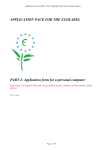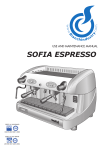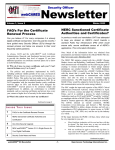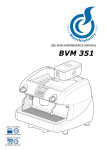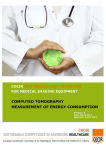Download read this position paper here
Transcript
COCIR Industry Guidance March 5, 2007 China RoHS Marking for Control of Pollution Caused by Electronic Information Products Effective March 1, 2007 1. SCOPE Includes: • Medical devices listed in List of Electronic Information Products (EIP) and sold to or within China • Refurbished products sold to China after March 1, 2007. (Such products are still not allowed on the Chinese market). OEM non-medical equipment sold with medical products, e.g. computers, printers, etc. • Accessories that are listed in List of EIP and are capable of being sold separately from the main medical device • Spare, support, upgrade, repair and service parts that are listed in EIP and sold as separate items via, e.g, a shop Excludes: • Non –electronic consumables (e.g., accessories) that are not listed in List of EIP • Spare, support, upgrade, repair and service parts not listed in EIP List or not sold as separate items or sold via B2B delivery (i.e., not in a shop) • Electronic components being part of a medical system that itself is labeled and sold with that system • EIP made in China and exported from China We should go for an exemption for all parts, which are sold separately but which will become part of a system. 2. DEFINITIONS Put on the Market Manufacturing date will be the time of “Put on the Market” Environmentally Friendly Use Period (EFUP) Period of time in years during which the toxic or hazardous substances or elements contained in electronic information products will not leak or mutate so that the use of these substances or elements will no result in any severe environmental pollution, any bodily injury or damage to any assets. It is proposed using one number (50 years) for all medical devices excluding those intended for short and medium term use (5 years). The product should be taken back (e.g. for recycling) after its EFUP has expired. 1/11 China RoHS Hazardous Substances These refer to lead, mercury, cadmium, hexavalent chromium, polybrominated biphenyl (PBB), polybrominated biphenyl ether (PBDE, exclusive of decabromodiphenyl ether), and other toxic or hazardous substances or elements specified by the State that are contained in electronic information products. References to “contain” in the China RoHS legislation mean that the contents of toxic or hazardous substances or elements exceed the limit requirements set forth in the China Standard ”Requirements for Concentration Limits for Certain Hazardous Substances in Electronic Information Products”. EIP may contain hazardous substances higher than the concentration limit and still be sold within or to China. Key Catalogue Products under the key catalogue must comply with restriction of the six hazardous substances and will require third party certification (China Compulsory Certification, 3C). To date the key catalogue is empty. MII is working on the qualification criteria, certification procedures, and market surveillance... Every year products may be added to this Catalogue and compliance will be required within the publicized transition period China RoHS Hazardous Substances Thresholds Thresholds are basically same as EU RoHS (but restriction date is not set yet, labeling required) “Others” as Contained in the List of EIP “Others” is a traditional Chinese expression, which means that the List may be updated later if necessary. If a product is not listed clearly in the list EIP, it may not be required to be labeled. Market surveillance Enforcement of China RoHS compliance to date is during ‘post marketing’. The local information industry authority will chair a local coordination group. The local coordination group will help companies to solve problems. The coordination group will issue an internal guidance document to instruct each ministry and its local branches. Checks by China Customs also may be possible. 2/11 3. REQUIRED TO BE MARKED ON THE PRODUCT See Figures 1 and 2 below. Logos • Logo 1 – when EIP contains China RoHS Hazardous substances below the concentration limit • Logo 2 – when EIP does contain at least one China RoHS Hazardous substance above the concentration limit. The entire logo 2 with the EFUP number included means that this electronic information product can be used safely during this time, and should be taken back (e.g. for recycling) immediately after its EFUP has expired. • Only Logo 2 is applicable for medical products at the moment. • Number 50 inside Logo 2 (intended for long term use EIP) and 5 (intended for medium and short term use EIP). Numbers are still in discussion. • When OEM products are part of the Medical System, physically attached or not, no label is required. If an OEM supplier provides an EFUP number (see below) for an OEM part and it differs considerably from the number of Medical system, it is acceptable to have the OEM part labeled separately and included in the declaration Table for the system. Medical products can still have a label at the system level that differs from the OEM part label. • Separate labeling is not really necessary as the OEM component with the shorter life time will be replaced, as needed, by normal maintenance, the same as any other part of the medical product system, (e.g. a battery), thus not requiring separate labeling and a separate table. Colors of Logos • China recommends Green for Logo 1 and Orange for Logo 2 • Grey, black and white labels are acceptable • Molded, pasted or printed mark on product can be the same color as product • Color should be distinguishable from product or prominent – so as to enable seeing it clearly Size and Location of Logos • The Logo should be marked directly on the product itself. If size or the function of the product prevents direct marking on the product itself, the Logo may be specified in the user manual or product instructions. If product is larger than 5 x 103 mm2, the Logo should be directly on the product. Further exceptions are when product has an irregular shape or when it is not possible because of functional or appearance restrictions (=> place logo in easy detectable place, e.g. compartment removable battery or in product documentation or instructions) or B2B delivery, spare parts, repair and maintenance. • Only mark on Systems level, i.e., highest level • Mark must be in a prominent location • EIP items sold separately need to be labeled along with System label • Logos should not be smaller than 5 mm x 5 mm and follow the dimensions as specified in Figures 1 and 2 • Font should be Microsoft Office or Word software, “Impact” 3/11 • 4. • • • • • • • • Labeling shall not be placed on the shipping container MATERIALS DECLARATIONS TABLE Table to be used for China RoHS labeling per 1 March 2007. Parts are big parts. (3 examples are given at the end of this document) The table must be in Chinese language - any other language together with Chinese is acceptable The tables in Examples 1- 3 below must be specified in the user, instruction or operation manuals of medical products or on a separate sheet or on a CD with the instrument; website alone will not meet requirements Only the presence or absence of the six China RoHS Hazardous substances needs to be indicated by means of an “X” or an “O”. The “X” signifies that the hazardous substance is present in excess of the Maximum Concentration Limit in a homogeneous material. There is no need to put the exact concentration of the hazardous substance there. For purposes of the table, assume that if a China RoHS Hazardous substance is present in the medical product, then it is present in excess of the Maximum Concentration Limit, rather than try to calculate the concentration in a homogeneous material Product name should go in the column titles “Unit Name” Information on OEM items need to be obtained from the OEM Suppliers If products are marked separately, separate tables are needed for each one 4/11 • Specify the presence or absence of the six China RoHS Hazardous Substances at the highest component/part level o It is advised to specify main parts, components or building blocks of the systems that have different China RoHS Hazardous Substances contents separately in the Table. Try to limit the number of parts listed as much as possible (<10 items listed) If an item is sold separately from the system and/or if it has its own user manual, include a separate Materials Declaration table in its users manual o Specify clearly to which system parts/components the declaration table(s) refer. Avoid including a line for the ‘Total System’. Do not list parts which do not contain any of the 6 substances Include potential upgrades and spare parts in the Tables. o • • • 5. PACKAGING RECYCLING MARKS Adhere to the national standard of the People’s Republic of China, “Packaging Recycling Marks”, GB 18455-2001 for the types, names, sizes and colors of marks for recyclable, reusable packaging and packaging that is renewable for utilization and/or GB/T 16288-1996 Mark for plastic recycling(same as marking according the EU directive 97/129/EC). 5/11 Symbol for Marking of (Green) EIP Which Don’t Contain any Hazardous Substances Logo 1 Green Color Larger than 5mm x 5 mm Figure 1 6/11 Symbol for Marking of EIP Which Contain at Least One Hazardous Substance Logo 2 H Red Color Di Do H : Di : Do = 5 : 8 : 12 : Font: Impact Figure 2 7/11 The number represents the actual environmentfriendly use period of the product – instead of “10”, use “50” for medical equipment and systems Example 1 Hazardous Substances Unit Name Lead (Pb) Mercury (Hg) Cadmium (Cd) Hexavalent Chromium (Cr6+) Polybrominated Biphenyls (PBB) Polybrominated Diphenyl Ethers (PBDB) Magnet All printed circuit boards LCD Monitor Other parts O X O O O O O O O O O O X X O O O O O O O O O O O: Means the hazardous substances in all the homogeneous materials are below the concentration limits defined in the Standard X: Means the hazardous substances in at least one of the homogeneous materials of the Unit exceed the concentration limits defined in Standard 8/11 Example 2 Hazardous Substances Unit Name Lead (Pb) Mercury (Hg) Cadmium (Cd) Hexavalent Chromium (Cr6+) Polybrominated Biphenyls (PBB) Polybrominated Diphenyl Ethers (PBDB) Metal parts O O O O O O Plastic/Polymeric O O O O O O parts Electronic X O O O O O modules Flat screens X X O O O O Cables and cable O O O O O O assemblies Sensors and X O O O O O transducers Radiation X O O O O O shielding X-ray beam O O O O O O forming Electromechanical O O O X O O parts O: Means the hazardous substances in all the homogeneous materials are below the concentration limits defined in the Standard X: Means the hazardous substances in at least one of the homogeneous materials of the Unit exceed the concentration limits defined in Standard 9/11 Example 3 Hazardous Substances Unit Name Lead (Pb) Mercury (Hg) Cadmium (Cd) Hexavalent Chromium (Cr6+) Polybrominated Biphenyls (PBB) Polybrominated Diphenyl Ethers (PBDB) Magnet Patient Table System Cabinet Coils X X O O O X X X X X X X X O X X X X X O O O O X O: Means the hazardous substances in all the homogeneous materials are below the concentration limits defined in the Standard X: Means the hazardous substances in at least one of the homogeneous materials of the Unit exceed the concentration limits defined in Standard 10/11 Annex: Nine China ROHS standards 1. Concentration Limits (MCV): same MCV as EU RoHS 2. Testing Methods: similar as IEC/TC111 WG3 standard with sampling instruction 3. Marking and Labeling: China characterized, follow the requirement of China RoHS regulation 4. Labeling of Packaging Materials: available since 2001 The following five standards are NOT compulsory. 5. Solder powder for electronic soldering application 6. Flux of lead-free solder 7. General technical requirement for solder paste 8. Lead-free solders—chemical compositions and forms 9. Test method for lead-free solders 11/11












